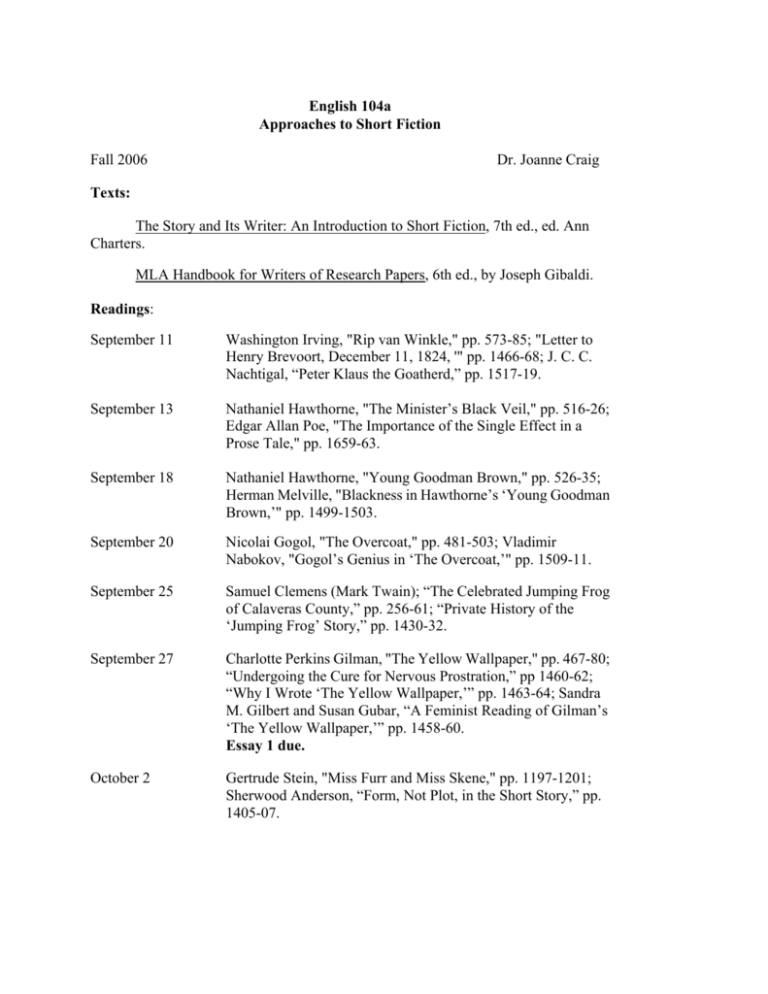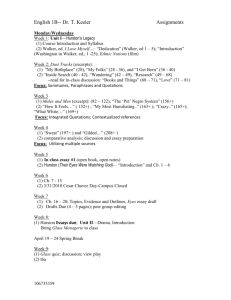ENG 104 Approaches to Short Fiction - Ubishops.ca
advertisement

English 104a Approaches to Short Fiction Fall 2006 Dr. Joanne Craig Texts: The Story and Its Writer: An Introduction to Short Fiction, 7th ed., ed. Ann Charters. MLA Handbook for Writers of Research Papers, 6th ed., by Joseph Gibaldi. Readings: September 11 Washington Irving, "Rip van Winkle," pp. 573-85; "Letter to Henry Brevoort, December 11, 1824, '" pp. 1466-68; J. C. C. Nachtigal, “Peter Klaus the Goatherd,” pp. 1517-19. September 13 Nathaniel Hawthorne, "The Minister’s Black Veil," pp. 516-26; Edgar Allan Poe, "The Importance of the Single Effect in a Prose Tale," pp. 1659-63. September 18 Nathaniel Hawthorne, "Young Goodman Brown," pp. 526-35; Herman Melville, "Blackness in Hawthorne’s ‘Young Goodman Brown,’" pp. 1499-1503. September 20 Nicolai Gogol, "The Overcoat," pp. 481-503; Vladimir Nabokov, "Gogol’s Genius in ‘The Overcoat,’" pp. 1509-11. September 25 Samuel Clemens (Mark Twain); “The Celebrated Jumping Frog of Calaveras County,” pp. 256-61; “Private History of the ‘Jumping Frog’ Story,” pp. 1430-32. September 27 Charlotte Perkins Gilman, "The Yellow Wallpaper," pp. 467-80; “Undergoing the Cure for Nervous Prostration,” pp 1460-62; “Why I Wrote ‘The Yellow Wallpaper,’” pp. 1463-64; Sandra M. Gilbert and Susan Gubar, “A Feminist Reading of Gilman’s ‘The Yellow Wallpaper,’” pp. 1458-60. Essay 1 due. October 2 Gertrude Stein, "Miss Furr and Miss Skene," pp. 1197-1201; Sherwood Anderson, “Form, Not Plot, in the Short Story,” pp. 1405-07. 2 October 4 Zora Neale Hurston, "Spunk," pp. 550, 559-63; “How It Feels to Be Colored Me,” pp. 1600-04; “What White Publishers Won’t Print,” pp. 1604-1608; “Harlem Slanguage,” 1608; Robert Bone, “A Folkloric Analysis of Hurston’s ‘Spunk,’” p.1609; Alice Walker, “Zora Neale Hurston: A Cautionary Tale and a Partisan View,” pp. 1613-15. October 16 Jorge Luis Borges, "The Circular Ruins," pp. 123-27; Julio Cortázar, “On the Short Story and Its Environs,” pp. 1437. October 18 John Cheever, "The Swimmer," pp. 212-21; "Why I Write Short Stories,'" pp. 1425-27. October 23 Mary Lavin, “The Widow’s Son,” pp. 738-46. October 25 Test. October 30 Julio Cortázar, "A Continuity of Paths," pp. 325-27. November 1 Ray Bradbury, "August 2026: There Will Come Soft Rains," pp. 151-55. November 6 Grace Paley, "A Conversation with My Father," pp. 1080-84; “A Conversation with Ann Charters,” pp. 1524-28. November 8 Gabriel García Márquez, “A Very Old Man with Enormous Wings,” pp. 461-66; “The Challenge,” pp. 1453-57. November 13 John Barth, "Lost in the Funhouse," pp. 84-101. November 15 Donald Barthelme, “The Indian Uprising,” pp. 102-06. Essay 2 due. November 20 Alice Munro, "Miles City, Montana," pp. 929-44; "How I Write Short Stories,” pp. 1508-09. November 22 Susan Sontag, "The Way We Live Now," pp. 1183-96; “Writing as Reading,” pp. 1547-48. November 27 Woody Allen, "The Kugelmass Episode," pp. 20-29. November 29 Margaret Atwood, "Happy Endings," pp. 42-45; “Reading Blind,” pp. 1407-11. December 4 Laurie Moore, "How to Become a Writer," pp. 909-14. 3 Print your essays if you can, and present them in the form prescribed in the sixth edition of the MLA Handbook. Please indicate your mailbox number on your essays. Marks: Marks are based on a test (15%), an examination (30%), two essays (15% and 30%), and attendance and participation (10%: please see p. 26 of the Bishop's University Academic Calendar for 2006-07). There will be no supplemental examination. Office Hours: Monday 14:00-14:45, Tuesday 13:30-14:15, Wednesday 10:30-11:15, and by appointment in Morris 11. Policy on Late Essays: 1. Hand in a hard copy of your essay either to the professor or to the English Department secretary, Ms. Cheryl Porter, Morris 2, no later than 16:00 on the day on which it is due. 2. If you need an extension, request it at least a day before your essay is due. 3. If you hand an essay in after the deadline without the prior consent of the professor, you will be penalized 5% per working day late. Policy on Plagiarism: According to the sixth edition of the MLA Handbook: "forms of plagiarism include the failure to give appropriate acknowledgement when repeating or paraphrasing another's wording, when taking a particularly apt phrase, and when paraphrasing another's argument or presenting another's line of thinking" (71). For details, examples of plagiarism, and instructions for avoiding it, please read the entire chapter on plagiarism carefully (65-75). Also read the section about academic integrity on p. 21 of the Bishop's University Academic Calendar for 2006-07. If you plagiarize you will receive a mark of zero for the essay concerned, and the Dean of Humanities will be informed. After a second offense you will receive a mark of zero for the course; again the Dean will be informed. . 4 Assignment for Essay 1 Due September 27, 2006 In a short, coherent essay of about 1000 words, answer one of the following questions, and support your answer. Try to be as specific as you can. 1. How are the plots of "Peter Klaus the Goatherd" and "Rip Van Winkle" similar and different? 2. How are the religious beliefs of Mr. Hooper and Goodman Brown similar and how are they different? 3. How can a knowledge of seventeenth-century New England or of Puritan theology or both enhance a reading of "Young Goodman Brown"? 4. How does satire work as a diversionary tactic in “The Overcoat”? 5. What is the relationship between the “Person of Consequence” and a person of little consequence? 6. Do you agree that disappointed expectation is the aim of Gogol's style in "The Overcoat"? 7. How does “The Celebrated Jumping Frog of Calaveras County” reveal the human tendency to be easily tricked or cheated? 4. How does Twain use different levels of language to represent the speakers' backgrounds and social classes in "The Celebrated Jumping Frog of Calaveras County"? 9. How does point of view work in “The Celebrated Jumping Frog of Calaveras County”? 10. How do humor and irony work in “The Celebrated Jumping Frog of Calaveras County”? 5 Assignment for Essay 2 Due November 15, 2006 In a short, coherent essay of about 1500 words, answer one of the following questions, and support your answer. Try to be as specific as you can. 1. How is the sound of the words in "Miss Furr and Miss Skeene" contribute to the meaning of the story? 2 How does rural humor work in “Spunk”? 3. What is Hurston saying about courage in "Spunk"? 4. How do the supernatural elements work in “Spunk”? 5. Why does Neddy Merrill only speak to women in "The Swimmer"? 6. What is the relationship of the three characters Rusty Towers, Eric Sachs, and Neddy Merrill? 7. How is “The Swimmer” the story of Neddy Merrill’s voyage of exploration and discovery? 8. What is the narrator’s attitude toward the swimmer in “The Swimmer”? 9. Which version of "The Widow's Son" is more true and why? 10. How does “A Continuity of Parks” resemble and how does it differ from “Miss Furr and Miss Skeene” or “Lost in the Funhouse” or “The Kugelmass Episode”? 11. What views of nuclear war emerge from “August 2026”? 12. How does Bradbury control time and action in “August 2026”? 13. What does “A Conversation with My Father” say about writing? 14. Is "A Conversation with My Father" primarily tragedy or satire? 6 15. What is the relationship between the enormous and the ordinary in “A Very Old Man with Enormous Wings”? Take the etymological meaning of enormous into account. 16. Is “A Very Old Man with Enormous Wings” a fairy tale, a myth, or an allegory? 17. How does García Márquez make you believe in his angel? 18. What is the basis of the appeal of “A Very Old Man with Enormous Wings”? 19. How would you compare the representation of the supernatural in "A Very Old Man with Enormous Wings" to that of Hawthorne or Hurston? 20. How does Barth use realistic narration in “Lost in the Funhouse”? 21. What does nausea mean in "Lost in the Funhouse"? 22. How does Barth use funhouse techniques like obvious imagery, abrupt changes, and sudden drafts from below? 23. “Lost in the Funhouse” resembles an author’s early draft of a traditional story. Outline both that traditional story and the story of the process by which it develops, and say whether you think Barth’s is an accurate account of the way stories are written. 24. Is Barth’s recurrent representation of the heroic native a cliché or a genuine historical model, and what does it suggest about the narrator’s state of mind?




